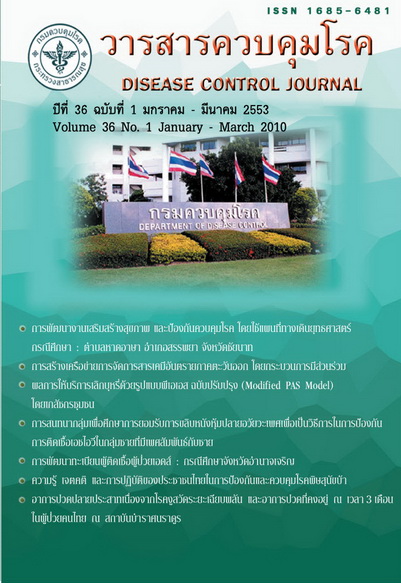Establishing Chemical Management Network in the East of Thailand by Participation Process
Keywords:
Chemical management network, East of Thailand, Participation processAbstract
Based on Participatory Action Research, this Research and Development comprised of 3 steps: 1) Preparing and planning 2) Action and 3) Evaluation. Its objective was to establish the chemical management network in the East of Thailand by participation process among organizations in governmental and private sectors. Purposive samples included voluntary officers responsible for chemical management in 2 provinces (Chonburi and Rayong). Data collection during April 2006 - October 2007 was obtained through activity record and evaluation of participation behavior. Descriptive analysis was presented in percentage. The products of the 1st step included conceptual framework and 4 steps of network activities with 5 activities. The 2nd step involved 38 organizations in the workshop and production of manuals for the personnel and the public. Participation building processes such as AIC (Appreciate Influence Control) and FSC (Future Search Conference) technic were applied in the workshop with 93% and 7% of network members at high and middle level of network participation, respectively. For the manual production, 82.6% and 17.4% of the members were at high and middle level of participation, respectively. The 3rd step indicated that the input and the process were good, activities were performed as planned, and the activities were useful and suitable for the problems in the area. In conclusion, the chemical management network in the East of Thailand was built up through the participation process driven by network activities. The key success factors included network coordination, regular activities, network outputs with shared benefits; whereas personnel change and interruption of some activities were main obstacles. The network sustainability, public participation, and application for other public health problems were suggested for the next steps of development.
Downloads
References
2. Thailand National Chemicals Management Profile 2005. ปัญหาสำคัญเกี่ยวกับการจัดการสารเคมีของประเทศไทย. [26 เมษายน 2550]; แหล่งข้อมูล: URL; http://ipcs.fda.moph.go.th/e_ipcs/thai/pro file/2005/chap3.htm? 2005= chap3
3. วิชัย สติมัย, หรรษา รักษาคม, ณรงค์ เนตรสาวิกา, ชะฎายุทธ์ ปัทเมฆ, พูนศักดิ์ ศรีประพัฒน์. รายงานการศึกษาการสร้างความเข้มแข็งเครือข่ายการจัดการสารเคมีอันตรายภาคตะวันออก ชลบุรี: สำนักงานป้องกันควบคุมโรคที่ 3 จังหวัดชลบุรี; 2550.
4. นลินี ศรีพวง, รัชนีกร ชมสวน, สมเกียรติ ท้วมแสง. กรณีศึกษาเพื่อกำหนดรูปแบบการเฝ้าคุม/การเฝ้าระวังโรค จากการประกอบอาชีพที่สัมผัสกับสารทำละลายในอุตสาหกรรมปิโตรเคมีและอุตสาหกรรม รถยนต์. นนทบุรี: กองอาชีวอนามัย กรมอนามัย; 2540.
5. สำนักนโยบายและแผนทรัพยากรธรรมชาติและสิ่งแวดล้อม. แนวทางการประเมินความเสี่ยงด้านสุขภาพอนามัยต่อประชากรที่อาศัย อยู่โดยรอบโรงงานอุตสาหกรรมประเภทเคมี ปิโตรเคมี ปิโตรเลียม. กรุงเทพมหานคร: กระทรวงทรัพยากรธรรมชาติและสิ่งแวดล้อม; 2546.
6. สำนักอนามัยสิ่งแวดล้อม. โครงการศึกษาและพัฒนาแนวทางการควบคุมป้องกัน และแก้ไขปัญหาเหตุรำคาญและอุบัติภัยจากมลพิษ ในพื้นที่ชายฝั่งทะเล ตะวันออกและนิคมอุตสาหกรรม. นนทบุรี: กรมอนามัย; 2544.
7. Thailand Focal Point for IPCS/IFCS. Food and Drug Administration, Thailand. [cited 2007 March 9]; Available from: URL; http://www2.fda.moph.go.th/ipcs/ipcs/tcsnet.asp
8. คณะกรรมการแห่งชาติว่าด้วยการพัฒนายุทธศาสตร์การจัดการสารเคมี. แผนยุทธศาสตร์การจัดการสารเคมีแห่งชาติ ฉบับที่ 3 (พ.ศ.2550 -2554) พิมพ์ครั้งที่ 1. กรุงเทพมหานคร: ชุมนุมสหกรณ์การเกษตรแห่งประเทศไทยจำกัด; 2550.
9. นิตยา เงินประเสริฐศรี. การวิจัยเชิงปฏิบัติการแบบมีส่วนร่วม. วารสารสังคมศาสตร์และมนุษยศาสตร์ 2544; 2: 61-62.
10. เชาวฤทธิ์ จงเกษกรณ์. การพัฒนารูปแบบการมีส่วนร่วมของชุมชนในการบริหารจัดการ ทรัพยากรน้ำ: กรณีศึกษาชุมชนลุ่มน้ำสะแกกรัง จังหวัดอุทัยธานี. (วิทยานิพนธ์ปริญญาศิลปศาสตรดุษฎีบัณฑิต). บัณฑิตวิทยาลัย. มหาวิทยาลัยนเรศวร; 2552.
11. Cohen J and Uphoff NT. Participation a place in rural development :Seeking Claify through specificity. World Development 1980: 110-115.
12. Erwin,W. Participation management: Concept, Theory and implementation. Atlanta: Georgia State University;
1967.
13. นฤมล นิราทร. การสร้างเครือข่ายการทำงาน: ข้อควรพิจารณาบางประการ. กรุงเทพมหานคร: มหาวิทยาลัย ธรรมศาสตร์; 2543.
14. ปุสตี มอนซอน. สกรรจ์ พรหมศิริ. ญาณีกรณ์ ธรรมโชติ. ดลทิพย์ พืชผลเจริญ. โครงการวิจัยและพัฒนาชีวิต สาธารณะ-ท้องถิ่นน่าอยู่ คณะสังคมศาสตร์และมนุษยศาสตร์ มหาวิทยาลัยมหิดล. กรอบแนวคิดการประเมินศักยภาพเครือข่ายสังคม. พิมพ์ครั้งที่ 1. กรุงเทพมหานคร: พี.เอ.ลิฟวิ่ง; 2547.
15. กาญจนา แก้วเทพ. เครื่องมือการทำงานแนววัฒนธรรมชุมชน. กรุงเทพมหานคร:สภาคาทอลิกแห่งประเทศไทยเพื่อการพัฒนา; 2538.
16. วนิดา วิระกุล. รายงานการประเมินผลการประเมินศักยภาพและการมีส่วนร่วมของเครือข่ายเลปโตสไปโรซิส ระดับตำบล. ขอนแก่น: คลัง นานาวิทยา; 2545.
17. ปาน กิมปี. การพัฒนาเครือข่ายการเรียนรู้การศึกษานอก โรงเรียนเพื่อการพึ่งตนเองของชุมชน. (วิทยานิพนธ์ดุษฎีบัณฑิต). บัณฑิตวิทยาลัย. จุฬาลงกรณ์มหาวิทยาลัย; 2540.
18. ประหยัด จตุพรพิทักษ์กุล. เครือข่ายการเรียนรู้เกี่ยวกับระบบเกษตรกรรมทางเลือกของชุมชน. (วิทยานิพนธ์มหาบัณฑิต). บัณฑิตวิทยาลัย. มหาวิทยาลัยเชียงใหม่; 2538.
19. วิมลลักษณ์ ชูชาติ. การนำเสนอรูปแบบของกระบวนการสร้างเครือข่ายการเรียนรู้ในการอนุรักษ์ทรัพยากรป่าไม้. (วิทยานิพนธ์ปริญญาดุษฎี บัณฑิต). บัณฑิตวิทยาลัย. จุฬาลงกรณ์มหาวิทยาลัย; 2540.
Downloads
Published
How to Cite
Issue
Section
License
Articles published in the Disease Control Journal are considered as academic work, research or analysis of the personal opinion of the authors, not the opinion of the Thailand Department of Disease Control or editorial team. The authors must be responsible for their articles.






